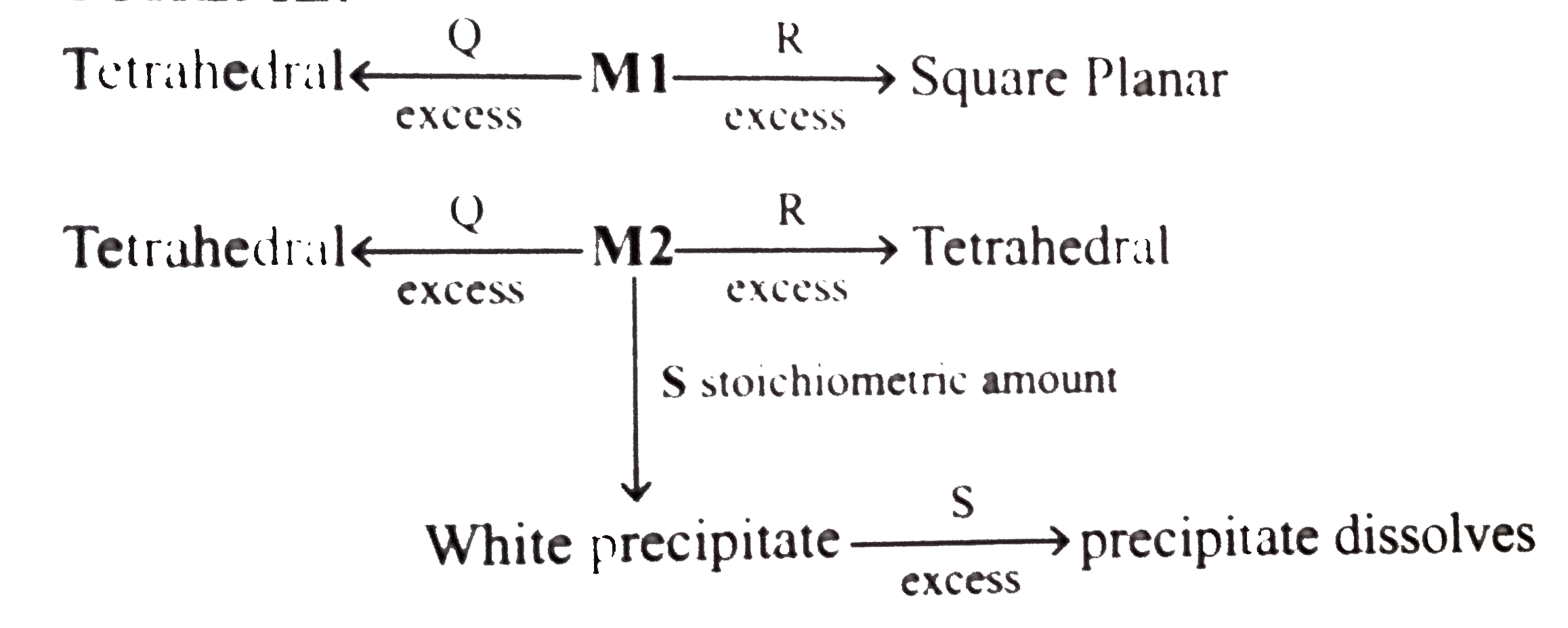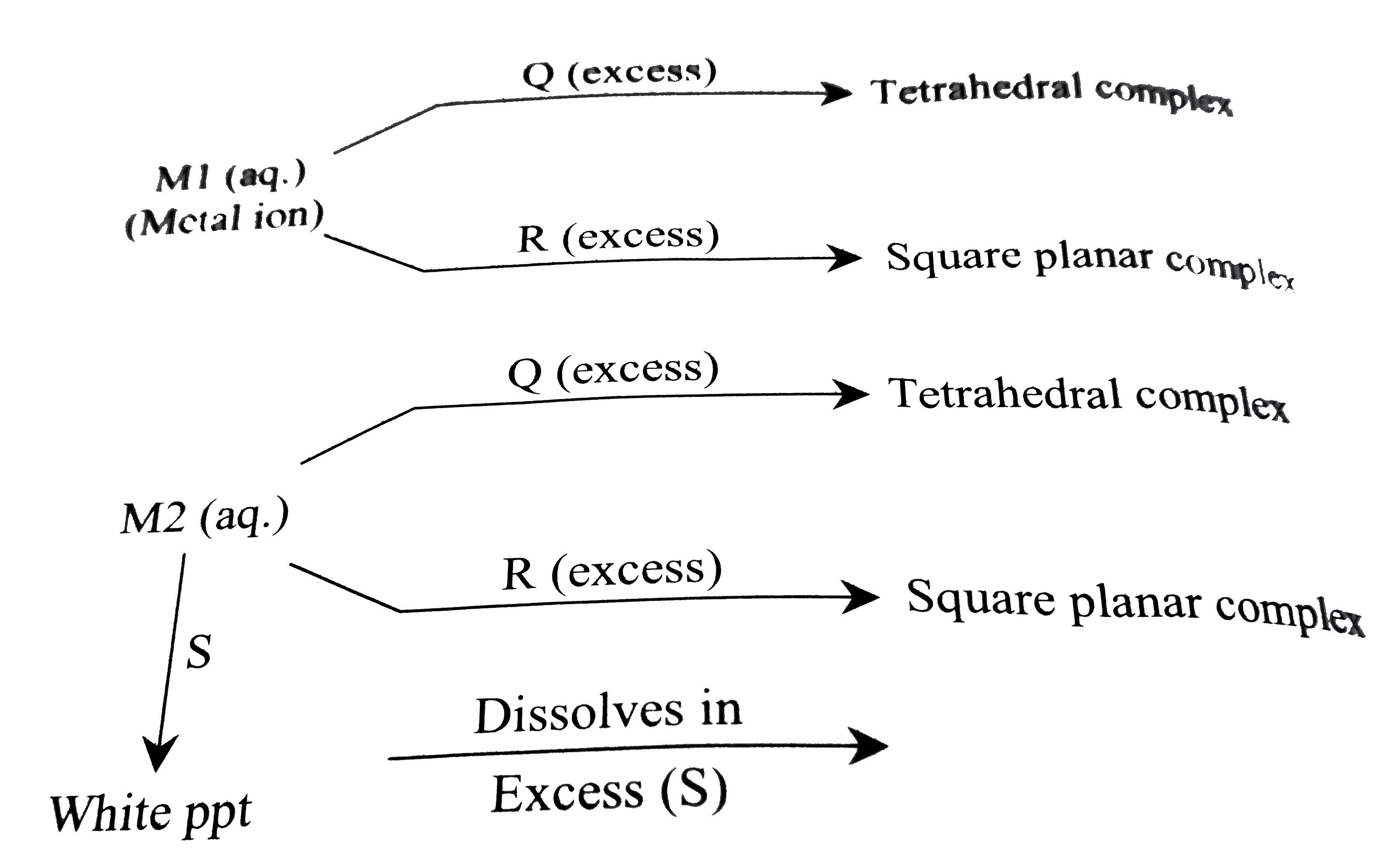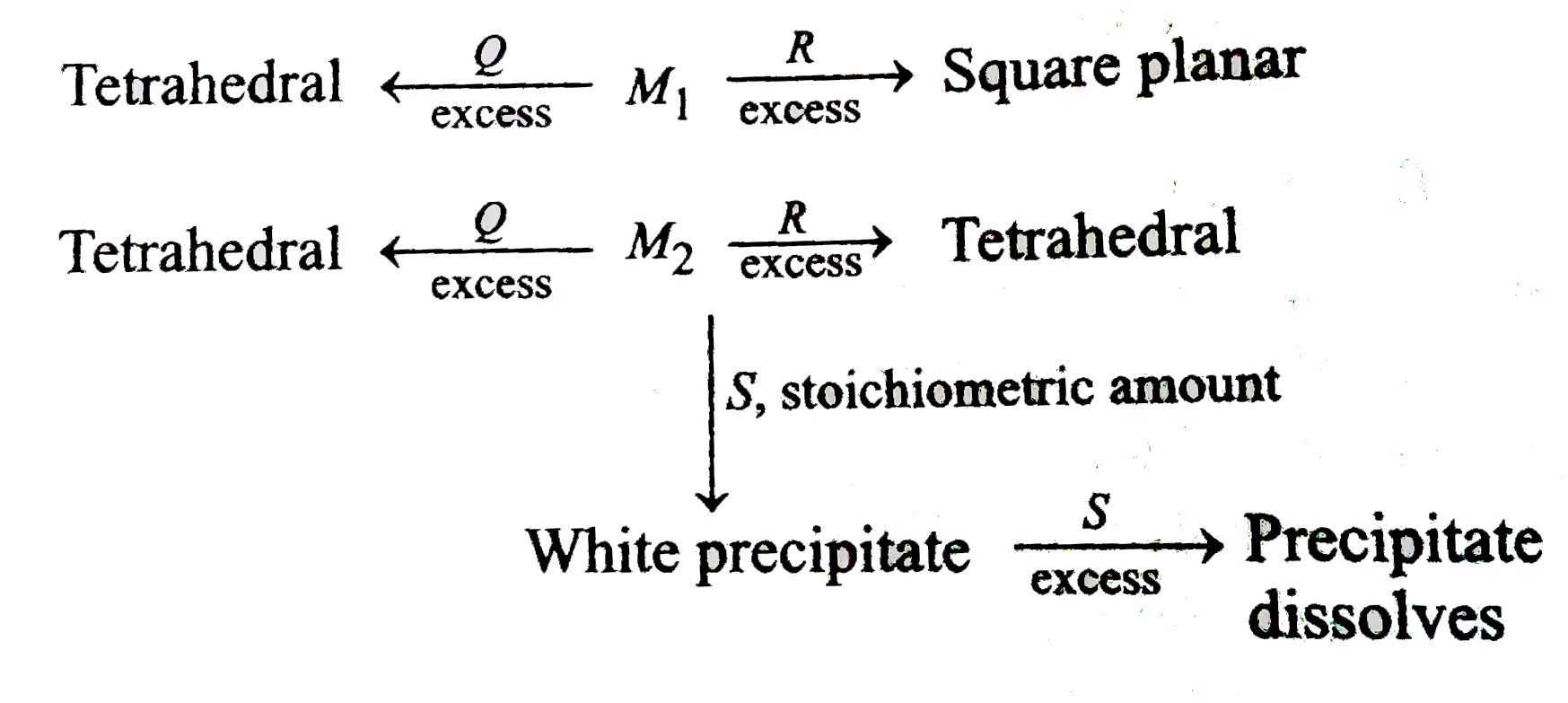An aqueous solution of metal ion MI reacts separately with reagents Q and R in excess to give tetrahedral and square planar complexes, respectively An aqueous solution of another metal ion M2 always forms tetrahedral complexs with theses reagents. Aqueous solution of M2 on reaction with reagent S gives white precipitate which dissolves in excess of S The reactions are summarised in the scheme given below: SCHEME :

what is M1,Q and R
Zn2,KCN and HCl
Ni2+,HCl and KCN
Cd2+ , KCN and HCl
Co2+ , HCl and KCN
The correct Answer is:B

Reaction with (S) indicates amphoteric nature of M2. Amongst the options mentioned for (S) in Question, only KOH can give a complexing agent OH− , which is its answer
[Note : M2 may be Zn2+, which (a) is amphoteric (b) has coordination number 4 and (c ) always from tetrahedral complexes. It may be noted that Be2+ will also qualify with these charactersitics.]
Let us consider the possibility of M1. M1 should be able to form square planner complelx ( dsp2 hybridization ) as well as tetrahedral (sp3) . This rules out Zn2+ and Cd2+ [∵d10 configuration will not allow dsp2 hybridization ]
Ni2+(aq.)+4CN−(excess)⇔Ni(CN)2−4(square planner)
Ni2+(aq.)+Cl−(excess)⇔NiCl2−4(tetrahedral)
[Note : Co2++6CN−(excess)→Co(CN)4−6, an octahedral complex ]
Topper's Solved these Questions
- COORDINATION CHEMISTRYBOOK - ERRORLESS CHAPTER - COORDINATION CHEMISTRYEXERCISE - JEE SECTION INTEGER TYPE QUESTIONS
8 Videos
- COORDINATION CHEMISTRYBOOK - ERRORLESS CHAPTER - COORDINATION CHEMISTRYEXERCISE - JEE SECTION MATRIX MATCH TYPE QUESTIONS
3 Videos
- COORDINATION CHEMISTRYBOOK - ERRORLESS CHAPTER - COORDINATION CHEMISTRYEXERCISE - JEE SECTION COMPREHENSION TYPE QUESTION (PASSAGE - II)
3 Videos
- CLASSIFICATION OF ELEMENTS AND PERIODIC PROPERTIES BOOK - ERRORLESS CHAPTER - CLASSIFICATION OF ELEMENTS AND PERIODIC PROPERTIES EXERCISE - JEE Section Matrix Match type questions
2 Videos
- D & P-BLOCK ELEMENTSBOOK - ERRORLESS CHAPTER - D & P-BLOCK ELEMENTSEXERCISE - JEE Section (Numeric answer type questions)
2 Videos
Similar Questions
An aqueous solution of metal ion M1 reacts separately with reagents Q and R in excess to give tetrahedral and square planar complexes, respectively. An aqueous solution of anotherr metal ion M2 always forms tetrahedral complex with these reagents. Aqueous solution of M2 on reaction with reagent S gives white precipitate which dissolves in excess of S. The reactions are summarized in the scheme given ahead.
SCHEME:
Tetrahedral Q←−−excessM1R−−→excess Square planar
TetrahedralQ←−−excessM2R−−→excessTetrahedral ↓S.stoichiometric amount White pptS−−→excess.Precipitate dissolves
Reagent S is:
View SolutionAn aqueous solution of metal ion M1 reacts separately with reagents Q and R in excess to give tetrahedral and square planar complexes, respectively. An aqueous solution of anotherr metal ion M2 always forms tetrahedral complex with these reagents. Aqueous solution of M2 on reaction with reagent S gives white precipitate which dissolves in excess of S. The reactions are summarized in the scheme given ahead.
SCHEME:
Tetrahedral Q←−−excessM1R−−→excess Square planar
TetrahedralQ←−−excessM2R−−→excessTetrahedral ↓S.stoichiometric amount White pptS−−→excess.Precipitate dissolves
M1,Q and R, respectively are:
View Solution
Knowledge Check
An aqueous solution of metal ion M1 reacts separately with reagents Q and R in excess to gie tetrahedral and sqaure planar complexes, respectively. An aqueous solution of another metal ion M2 always forms tetrahedral complexes with these reagents. Aqueous solution of M2 on reaction with reagent S gives white precipitate which dissolves in excess of S. The reaction are summarised in the scheme given below
Scheme

Reagent S isAK4[Fe(CN)6]BNa2HPO4CK2CrO4DKOHIn Aqueous solution, metal ion M1 reacts separately with reagents Q and R in excess to give tetrahedral and square planar complexes respectively. An aqueous solution of another metal ion M2 always froms tetrahedral complexes with these reagents. Aqueous solution of M2 on reaction with reagent S gives white precipitate which dissolves in excess of S. The reactions are summarized in the scheme given ahead

Reagent S isAK4[Fe(CN)6]BNa2HPO4CK2CrO4DKOHAn aqueous solution of metal ion M1 reacts separately with reagents Q and R in excess to gie tetrahedral and sqaure planar complexes, respectively. An aqueous solution of another metal ion M2 always forms tetrahedral complexes with these reagents. Aqueous solution of M2 on reaction with reagent S gives white precipitate which dissolves in excess of S. The reaction are summarised in the scheme given below
Scheme

M1,Q and R, respectively areAZn2+,KCN and HClBNi2+,HCl and KCNCCd2+,KCN and HClDCo2+,HCl and KCN
In Aqueous solution, metal ion M1 reacts separately with reagents Q and R in excess to give tetrahedral and square planar complexes respectively. An aqueous solution of another metal ion M2 always froms tetrahedral complexes with these reagents. Aqueous solution of M2 on reaction with reagent S gives white precipitate which dissolves in excess of S. The reactions are summarized in the scheme given ahead

M1, Q and R respectively are
View SolutionAn aqueous solution containing S2− ions will not give:
View SolutionAn aqueous solution containing S2− ions will not give:
View SolutionOn addition of aqueous NaOH to a salt solution, a white gelatinous precipitate is formed, which dissolves in excess of alkali. The salt solution contains
View SolutionIf NaOH is added to an aqueous solution of Zn+2 ions white precipitate appears and on adding excess NaOH, the precipitate dissolves. In solution zinc is in the
View Solution
